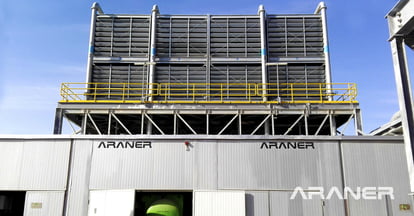During the refrigeration or industrial cooling cycle, heat is extracted from a cold system and thus needs to be rejected to a hot system. In order to achieve this, there are many heat rejection methods, and ARANER are specialists in the top 5 condensation technologies for heat rejection. First, the proper study of your plant is necessary to determine constraints and opportunities. In our Condensation Technologies Whitepaper, discover the main points to consider when implementing a heat rejection system. Only then will you find an appropriate and effective condensation technology for your specific applications and purposes. For a short introduction to ARANER’s 5 Condensation Technologies, read below. For a more in-depth look at the applications, advantages, and disadvantages of each method, download our expert whitepaper.
Seawater or River Water Condensation

Figure 1: An aerial view of the Dubai, UAE waterfront
Water covers over 70% of the Earth’s surface, so choosing a method that uses water is a smart choice, as water is readily available in most parts of the globe . The Middle East region has prime access to the sea, counting the Indian Ocean, Persian Gulf, Gulf of Oman, Arabian Sea, and Red Sea among its bodies of water, not to mention its lakes. When using the Earth’s superficial water to reject heat for industrial refrigeration, heat is transferred from the cooling system to the water. Find out the features of these heat rejection methods in our condensation whitepaper.
Air Condensation
In large regions like the Middle East, water is not always abundant; thus, your plant or facility may not be located near enough to a water source to take advantage of seawater or river water heat rejection methods. For cases like this, you might consider air condensation, where heat transfer and rejection are carried out through a series of coils and fans. As its name suggests, air condensation means rejecting the heat directly into the ambient air and this method uses no water.
Cooling Towers

Figure 2: Cooling Tower for heat rejection
An industry staple, cooling towers are a trusted method for cooling within a variety of industries, from Petrochemicals to Power Plants to District Cooling. Using cooling tower condensation for heat rejection has been a proven choice over the years due to its adaptability and due to high efficiencies achieved in dry climates like the Middle East. However, due to their large and visible nature, aesthetics and the surrounding environment may need to be taken into account when considering implementing cooling towers.
Effluent Condensation
To increase efficiency and to use all the resources at your disposal, effluent condensation can be incorporated into your systems and processes. An interesting note is that it can be combined with seawater, river water, cooling towers, and air condensation technologies.
Conclusion
Heat is a by-product of any industrial system, and knowing how to reject heat efficiently is an integral part of any power plant or cooling plant. With the top 5 Condensation Technologies on the market, ARANER can help you find the best fit for your project. Our experienced team carries out every study and analysis with expert precision and successful results. To research the pros and cons of each method, industry applications, and points to consider when undertaking a Heat Rejection project, consult our Condensation Technologies Whitepaper by clicking on the link or filling out the form below.










